- Submissions

Full Text
Approaches in Poultry, Dairy & Veterinary Sciences
Assessment of Broiler Production; Processing and Marketing Practices in Ethiopia: Identifying the Root Causes for Poultry Products Importation to Ethiopia And Way Forward
Teshome T*, Bekele E, Million B, Hagos S and Eshetie T
Ethiopia Meat and Dairy Industry Development Institute, Ethiopia
*Corresponding author: Tadesse Teshome, Ethiopia Meat and Dairy Industry Development Institute, Bishoftu, Ethiopia
Submission: October 10, 2019;Published: November 12, 2019

ISSN: 2576-9162 Volume7 Issue2
Summary
As opposed to the high national demand for broiler meat in Ethiopia, the production and processing companies are not benefited in the market. A huge broiler meat has been imported to Ethiopia by International star hotels, supermarkets and Ethiopian airlines from different parts of the world. Therefore, this research work is initiated to assess the status of broiler production and processing practices in Ethiopia in order to provide current information for further study on poultry industry development. The research is basically a field study supplemented with secondary data from the national and international data sources. The primary data was collected from selected broiler producers, processors, supermarkets and international star hotels and also Ethiopian airlines. The research was conducted in purposively selected sites where you find broilers production, processing and also marketing. For the interview purpose, 21 broiler farms and 4 broiler meat processors were used. The collected data was analyzed using descriptive statistics and SPSS. The result of this study generally indicated that the broiler production systems observed by study team is classified into two broad categories, commercial broiler production system and small-scale broiler production system. Facilities used in both production systems is different based on their investment capacity, level of their knowledge and scope of their market outlets. In both production systems and processing units, there is not any standard for their products, traceability for their products is very difficult, the type of transport system they are using for their products is not to the standard. the informal marketing channel is dominant, the application of international food safety measures like ISO, HACCP and GMP literally absent, shortage of skilled manpower in the sector is a very serious problem and the market information system and access to credit and incentive is very shallow. The other challenge is the involvement of the middlemen in the marketing process who take the major share of the margin. Therefore, because of these interlinked challenges and others, the producers and processors are not benefited from their business as a result there is a continuous broiler meat importation. Hence, continues capacity building in-terms of man power, facilities, access to credit, incentives, market information system, issuance of rules and regulations for binding challenges in marketing, products traceability system, cold chain facilities, policy direction in products importation, food safety measures and investment promotion in production and processing are very important. Strong and sustainable linkage among major stakeholders is very important as well. Further research is needed to see the products origin, trends and the actors involved should be studied.
keywords Importation; Marketing; Processing; Production
Introduction
Poultry production and product consumption are gradually growing in the world. Poultry accounts for about 33% of the global meat consumption and is expected to grow at 2 to 3% per year in the world. A number of literatures indicated that large size poultry farms were more efficient, but these farms are few in the developing countries. As one of developing country, Ethiopian poultry sector is not yet to satisfy the growing needs of customers. The data shows that contribution of the subsector to the GDP estimated 4,172 million ETB per year. According to CSA 2016/17 [1], in Ethiopia there exists around 59.5 million chicken populations of which 96% indigenous, 2.79% hybrid and 1.35% exotic breeds. The estimated annual production of poultry meat in Ethiopia is 61,840 tons, which accounts for 1.3% share of the production in Africa and 11.7% of East Africa [1]. As a country to address the protein demand and improve the livelihood of the people, development of poultry production and processing sectors are some of the focus areas by government. Towards to this end, the livestock master plan document is produced to serve as national guiding document.
Against the government poultry development strategy, now a days, a huge amount of broiler meat is imported from different countries to Ethiopia by Ethiopian airlines, by five-star hotels like Sheraton Addis, Hilton, Radisson Blue and others. Ethiopian airline alone has been importing 2000 kg of broiler meat every day from South Africa and other sources. As a result of this, the local chicken meat processors are not benefiting and complaining on the lack of reliable market system in the country and demanding some protections from the government. Similarly, the country is scarifying its meager foreign currency resources by importing these products [2].
Therefore, this study is initiated to evaluate the current broiler production and processing and marketing activities in Ethiopia and to identify the major reasons why we import broiler meat from outside world and also to propose possible solutions with the following specific objectives.
Research objectives
a. To assess the current broiler production activities, facilities used, production premises
b. To assess the broiler processing techniques, their facilities, logistics and local marketing routs, market actors and their day to day challenges
c. Review the trends of poultry products importation and product type and market actors
Methodology of the Study
This study has been conducted at selected sites of Oromia (Adama, Bishoftu, Awash, Modjo, Addis Ababa and Hawasa (SNNP) where we can find more broiler production and processing establishments.
The target groups for the study include; broiler producers of all kinds; broiler meat processors; supermarkets; resource people from major and relevant sectors; retail traders consumers and researchers. The research is a field study and utilized different data sources including primary and secondary data. With regard to the primary data sources, the pretested questionnaires were used for the interview and conducted among sample respondents selected from relevant organizations. Also check list were used for interviewing Hotels, Ethiopian Airlines people and supermarkets. Continuous observation of broiler production and processing units and face to face discussions with focus groups was made and key stakeholders also selected for more data collection. Secondary source of data come from books, and journals, research outputs, CSA data etc. The data was analyzed using descriptive and excel sheet as required [3-5].
Sample size determination and proceduresSince the population was not large enough and not all the broiler producers in the country are formal, the researcher decided to come up with a sampling frame which involves people whose activities affect the poultry business in one way or the other. There is one main type of sampling techniques chosen for this study, judgmental sampling technique; also called purposive sampling was used to select respondents.
Classification of respondents and sample sizeBased on the use of judgmental sampling techniques respondents were classified as shown in Table1.
Table 1: Classification of respondents and sample size.
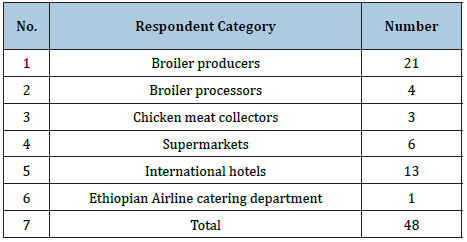
Data collection
In designing the questionnaire, both open and closed ended questions were used depending on the situation. This was to ensure that information obtained was accurate and could be reliable. Free interviews and focus group discussion were used to request information relevant to the study from some respondents.
Data analysisIn this study, the researcher relied on Microsoft Excel and descriptive statistics as required in analyzing the data. Frequency distribution, percentages, bar charts and descriptive analysis evaluating the challenges and prospects of broiler production, processing and marketing in the country used to examine the research questions.
Result and Discussion
Figure 1: Respondents classification.

The study considers demographic characteristics such as gender, age, and educational level which are relevant and important to the study. This is so because these characteristics show the various classes of respondents and how the classes influence the perceptional views, choices, preferences, etc associated with the topic. In general, the demographic profile indicated that 90.5% of the respondents are males and the rest of the balance is female respondents as indicated in Figure 1. According to respondents, now a days the broiler production and processing business is considered to be laborious and quite a risky venture and also needs capital. This explains why the industry attracts more males than females (Table 2).
Table 2: Age of respondents (Poultry farm owners).

As we observed the age classification of the respondents during survey, the high percentage fall within the age of above 30. This indicated that the involvement of the experienced people become evident for the industry to be more sustainable and competitive in the market. As indicated in Figure 2, more educated people (85.71%) is involved in the sector which is also a solid foundation for transfer of modern technology. The major share of the respondents with diploma and above on related fields (agriculture, marketing, and management) is also important to easily understand poultry business and can properly manage their farms. The remaining respondents also understand poultry farming and selling chickens but do not know about modern system of production in the poultry industry [6,7]. It is also observed that a number of farms have managers but most of the farms managed by their owners. These educated personnel in the field are directly involved in both the technical as well as managerial activities which also minimizes the overhead costs.
Figure 2: Educational background of respondents.
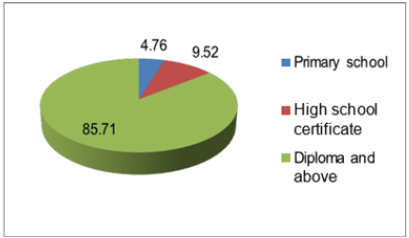
Broiler production system
Broiler production systems observed by study team can be classified in two different categories.
- Commercial broiler production system which is intensive production system involves an average of 10,000 broilers kept under indoor conditions as one batch with a medium bio-security level (Alema and Elfora farms). Comparatively those farms are well experienced and required intensive inputs such as feed, housing, health, and modern management systems. In this case the number of employees is more, and the invested capital is relatively higher as compared to small scale broiler farms. Usually the source of their replacement stock is either imported or from their broiler parent stock.
- Small scale broiler production system produced along commercial lines using relatively modern management methods. This activity is being undertaken as a source of income in and around major cities and towns. Their flock sizes usually ranges from 2000-5000 broiler chicks kept for operating and most of these farms obtain their feeds and day old chickens from the large scale commercial poultry broiler farms and involved in the supply of broiler meat to various supermarkets and hotels through middlemen. Their production system is characterized by medium level of feed, water and veterinary service inputs and low biosecurity. Mostly family labor involvement is to the higher side.
Most of the big broiler farms are located in appropriate area with convenient for transportation, with sufficient water supply and open space for good air movement. Those who are working in residence (rented house) areas are found not appropriate for good broiler rearing. Also sheds constructed by some municipalities are not to the standard and the distance from one farm to another is very minimal. But farms like Alema, Elfora, Hayma poultry, Adama poultry, ELER farm and, SW poultry have a good layout and sufficient space between broiler houses, with feed storage, equipment storage, office area and waste disposal area. As it was observed all farms have some experience how to prevent pathogens from entering to poultry farms and try to apply some bio-security rules and regulations. In almost all broiler poultry house, there is the practice of periodic disinfection. Equipment used such as feeders and drinkers are appropriate and ensure proper operation (almost the same material used in all farms). Common litter materials used by most farmers are chopped straw but Alema and Elfora used sawdust. Majority of broiler producers selling live chicken and few farms selling stuffed chicken even if they are not legally registered like processors [8-10].
Figure 3: Marketing channel for broilers and broiler meat.
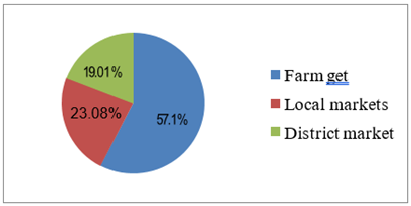
According to Figure 3, 57 % of the respondents sell their live broiler at farm gates while 23% on local market and 19% at district market. But few processors supply their products to poultry meat collectors, and they sell product for supermarkets and Hotels. The selling price of live broilers are determined by market situation and sometimes the brokers have main roll to limit price. The prices around Debrezeit and Addis Ababa were almost similar. In most cases the price of broilers depending on the season and cost of feed taken by broilers and their location to the big market. As a source of feed, more than 50% of broiler farmers use their feed mills, the rest who have small numbers of broilers or that who use rented house for keeping broilers purchase from Alema koudjs or other feed processors.
Technical supportIn relation to technical support, the broiler producers whether they get any technical support from any organization half of commercial poultry farm (52%) respondents inform that they get technical support from MOLF; NGOs and Research Centers. The rest of poultry producers (48%) carry out their poultry activities with their own knowledge and seek technical support (training on broiler production, processing and marketing) from different organization.
Environment controlAll farms tried to prevent odor and pathogens by removing garbage, dead birds, litter materials and other waste and destroy by burning in pit and/or filling pit by soil. Some are using incinerators for similar purpose. Small holders which have limited area to destroy dead broilers they filled waste by large plastic bags and go to some distance areas so as to dump in any open areas which finally cause environmental pollution and potential disease risk.
Major challenges of broiler productionChallenges mentioned by broiler producers are, limited access to land for poultry production and to produce maize and soya beans as an input for poultry feed, inadequate and poor access to quality feed from the local market, limited access to import parent stock or lack of day old broiler chicks, inefficient animal health service due to lack of drug supplies and quality vaccines, seasonal fluctuation of demand, lack of finance, shortage of foreign currency and absence of protective trade policy to encourage domestic private investors in poultry business. In addition to these, the poor linkage between the industries and higher learning institutes and the poor inter sectoral relationships do also contribute to the poor performance of the sub-sector. Therefore, processed broilers will never compete with international producers and this means there have to be strict import barriers for poultry products in place as well as admission that Ethiopia will never be in a position to export processed poultry products. The local quality of processed chicken is nowhere near international standards and this needs focus on to improve.
Broiler meat processing features in EthiopiaProcessed poultry products, including chilled or frozen broiler meat, currently account for a small share of urban household consumption and a negligible share of regional consumption. Chilled whole birds and/or parts can be found in supermarkets and big shops in major cities and are also consumed in institutional settings, including restaurants and hotels. Frozen birds and parts are more difficult to find at the retail level but can be found in shops in major cities and are also marketed by processors directly to hotels and restaurants. Currently there are five licensed poultry product processors with slaughtering and processing facilities (EMDIDI Poultry Directorates annual report, 2017). Three of them medium scale and two others are small scale. In another ways traditional poultry processing still accounts for roughly 80 percent of all processed poultry meat supply in the country [11]. The traditional poultry dressing facility at the small holders or retail level are completely manual, with no apparent sanitary measures taken for either for housing, facilities and for the workers.
Comparatively the modern poultry processing farms which are mentioned above, altogether on the average process about 1,386 tons of poultry meat/year (EMDIDI 2017 annual report). These firms operate under semi-automatic plants or basic processing equipment. Conditions in each of the five plants visited during the study period appeared to be better than the traditional one and they tried to comply with some of the requirements. They are better in using cold stores for the end products, hygiene, machineries, equipments and also availability of cold tracks (Table 3).
Table 3: Equipment used during processing.
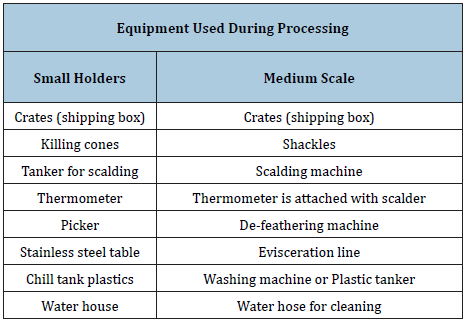
Market and size of broilers
The market structure for poultry products defined as open (informal) and formal markets (progressive). The informal market is mainly for small scale producers which sales live broilers to the surrounding and for the middlemen. This type of marketing systems become dominant mostly during holy days. The market channels for primary and secondary producers are retailers, supermarkets, hotels and diplomatic society. This market system has not yet well developed logistically and are not well equipped. The average broilers live weight is 2.5 kg with a dressed weight of 1.5 kg at a fattening period of around 56 days. There is no current data on the present per capita consumption, but according to the data from Global poultry trend 2013 country per capita consumption 0.6 keg /year. This is lower than the African average which is around 6 kg and much lower than the world average of 33 kg [12-14].
Major role players in poultry meat marketingInternational hotels in Addis Ababa and the surrounding: The result of the current study indicated that 90% of the interviewed hotels are buying chilled poultry meat from domestic producers and supermarkets except Sheraton Addis and Hilton Hotel, which use chicken meat from both domestic and foreign markets. The main reason given for importing poultry meat from abroad is the deficiency of some value-added chicken meat and quality product in domestic markets. But six international hotels from Addis, two hotels from Adama interviewed mentioned that they didn’t import poultry products but indicated as how it is very difficult to get sustainable, reliable and locally produced poultry meat. Generally, the major barriers in poultry meat production which were mentioned by informants are low quality, packaging problem, limited supply and sustainability, sanitation issue, over all food safety challenges and need for certification. As observed during assessment most of the hotels interviewed indicated that they would like to obtain fresh locally produced chicken meat and they have specific requirements in product quality, reliability of delivery and product differentiation and food safety.
Ethiopian airlineEthiopian Airline provides to all its passengers to all flights with food and food service consisting of hot meals, hot or cold snacks, or light refreshments, depending on the length of the flight and the time of the day. To satisfy the customers’ needs the airline imports different type of food items from abroad. As Ethiopian airline catering department EAL response, on the average they import 2000 kg chicken cube from Brazil through Dubai. As a main buyer they have specific requirements in product quality, reliability of delivery and product diversification. Like the international hotels, the reason for importing poultry meat from the outside world is limited supply, food safety issues and minimum products type available in the domestic market. According to Ethiopian Revenue and Custom Authority different years report, the origin and type of poultry meat imported varies. The ERCA, 2016 [15] report which include the type of the products, country of origin and their value is summarized in Table 4 below.
Table 4: Imported poultry products 2016 (Custom office).

Supermarkets
Most of the supermarkets in and around Addis Ababa buy packed poultry meat in plastic bags from the middlemen and some producers and resell it to their customers depending their customers preference. Also, they import or buy imported poultry products from importers to satisfy the local supply gap. Customers from supermarkets are expected to pay on the average 70-80 Birr/kg of fresh locally produced poultry meat but the average price of imported chicken meat costs 110-120 Birr/kg. According to supermarkets respondents, the price of poultry meat varies depending on size and the season. On the time of fasting purchase quantity will decline but price is the same with nonfasting time. As it is known, raw foods of animal origin should be stored at the temperature between one and four degrees Celsius. The supermarkets follow this guideline closely. Moreover, they kept their refrigerated poultry meat on an average of seven days. According to the respondents addressed in this survey, there is a high consumer demand for chicken meat in domestic market. In general, the challenges associated to broiler meat supply value chain in Ethiopia are too many, but the major ones are summarized in Table 5.
Table 5: Challenges raised by respondents are the following.
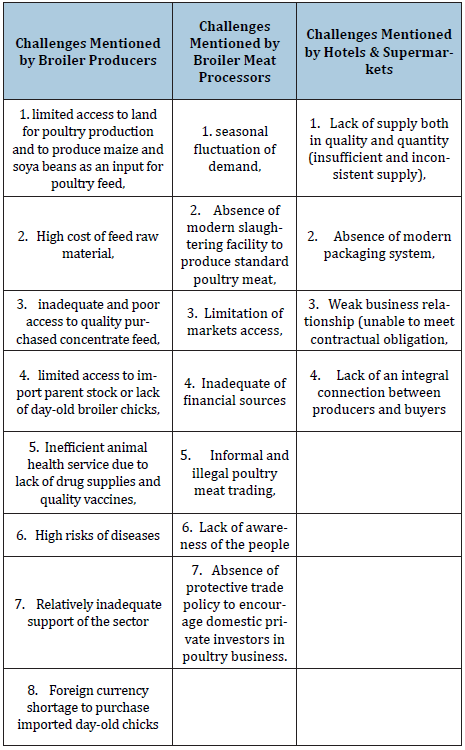
Conclusion
Poultry production and consumption is highly growing agribusiness in the world. Moreover, the socioeconomics of poultry production is also acceptable and feasible. This all makes poultry production the preferred and recommend production types to supplying the future protein demand of the society. In Ethiopia the poultry sector has a long history, but its growth is very sluggish. There are around 59.5 million chicken in the country of which more than 96% is local ecotypes with traditional production system. The broiler industry is also at its very infant stage
mostly concentrated in and around Addis Ababa catchment. There are some broiler farms both small scale and medium type and there are also some broiler meat processing units of different nature. They supply their products to retailers, middlemen people, direct to supermarkets and stare hotels. But due to the vast demand and supply gap in poultry meat supply, a huge amount of broiler meat is imported from the outside world. The major reasons why Ethiopia is not self-sufficient in broiler meat production and supply are too many but the major ones include production and processing premises are below the standard, the informal marketing channel is dominant, the application of international food safety measures like ISO, HACCP and GMP literally absent, shortage of skilled manpower in the sector is a very serious problem and the market information system and access to credit and incentive is very minimal. Therefore, because of these interlinked challenges and others, the producers and processors and not competent in the market and not benefiting from their business as a result there is a continuous broiler meat importation to Ethiopia.
Recommendations
This study has been trying to figure out the major challenges to the poultry industry in Ethiopia and suggest the following recommendations based on the realty on the ground and the existing potential in the country.
a. Support poultry product processors to meet the specific requirements of the costumers through strengthening the broiler production system and establishing standards for specific products.
b. Create awareness on quality and reliability of delivery, encouraging products development and diversifications of poultry meat at different supply chain stages all stakeholders along the broiler meat value chain.
c. Develop product promotion strategy by creating awareness of the general public and facilitate direct market linkages among value chain actors
d. Strengthening Poultry Producers and Processors Association through government support to reach the major broiler producers and processors.
Support and attract investors to invest in poultry industry by using different incentives.
References
- (2016-2017) CSA, FAOSTAT.
- Vernooij AG, Cornelissen JMR, Claassen IJTM, Beitler E, Rees HL, et al. (2012) Poultry in Ethiopia: a survey of production, value chain and marketing of commercial poultry in Ethiopia. NABC report, Netherlands, pp: 1-33.
- Boere A, Vernooij A, Duns H, Legesse M, Kidane D, Poultry sub-sector. Investment opportunities in the Ethiopian. Auke Boere Hilde Duns Dawit Kidane. Adriaan Vernooij Wageningen UR Livestock Research Mebratu Legesse Agri- Business Support Facility. NABC, Ethopia, pp: 1-19.
- (2004) India’s poultry sector: development and prospects. USDA Agricultural trade reports, India, pp: 1-67.
- Country reports and secondary data from the internet.
- (2001) Poultry meat processing Edited by Sams RA. CRC Press, USA, pp: 1-345.
- Poultry Industry Lesson Plans, pp: 1-16.
- Ahmad Al Khraisat AA (2013) Economic analysis of poultry (broiler) production in Amman and Irbid district in Jordan. International Journal of Life Sciences and Research 1(1): 24-30.
- FAO (2010) Poultry meat and eggs. Director of Investment Centre Division FAO, Agribusiness handbook. Rome, Italy, pp: 1-77.
- Nyaga p (2007) Poultry sector country review. FAO Animal Production and Health Division, Kenya, pp: 1-57.
- (2010) Partnership for safe poultry in Kenya (PSPK) program regional poultry value chain analysis. The United States agency for international development, USA, pp: 1-42.
- Central Statistical Authority (CSA) (2014) Agricultural Sample Survey Vol. II. Statistical Bulletin No. 331, Addis Ababa, Ethiopia.
- (2015) Poultry production manual (Yenesew Abebe, Agraw amane, Yihenew G.Selassie and Dessalegn Molla).
- Mengesha M (2013) Biophysical and the socio-economics of chicken production. African journal of agricultural research 8(18): 1821-1836.
- (2016) Ethiopian revenue and custom authority.
© 2019 Teshome T. This is an open access article distributed under the terms of the Creative Commons Attribution License , which permits unrestricted use, distribution, and build upon your work non-commercially.
 a Creative Commons Attribution 4.0 International License. Based on a work at www.crimsonpublishers.com.
Best viewed in
a Creative Commons Attribution 4.0 International License. Based on a work at www.crimsonpublishers.com.
Best viewed in 







.jpg)






























 Editorial Board Registrations
Editorial Board Registrations Submit your Article
Submit your Article Refer a Friend
Refer a Friend Advertise With Us
Advertise With Us
.jpg)






.jpg)














.bmp)
.jpg)
.png)
.jpg)










.jpg)






.png)

.png)



.png)






